Mold, Smoke, and Contamination: The Hidden Threats Lurking After Disaster

When the last flame flickers out or the final puddle is mopped up, it’s tempting to breathe a sigh of relief. The danger appears to be gone, but don’t forget about the lingering smoke. The home looks intact. Maybe a wall needs repainting, a carpet needs drying—but the worst is over.
Or is it?
In truth, some of the most destructive effects of fire and water events reveal themselves not during the chaos, but in the silence that follows. That’s when hidden threats begin to take hold—beneath floors, inside HVAC systems, and behind walls.
This is where restoration demands more than cosmetics. It demands science, strategy, and follow-through.
Mold: The Unseen Intruder
Water never stays where it starts. It seeps down into subflooring, travels laterally beneath tiles, and is absorbed by drywall like a sponge. Even when surfaces feel dry to the touch, moisture often remains deep within building materials.
Within 24 to 48 hours of exposure, mold spores can activate.
Common misconceptions:
- “I dried it with fans.” Surface drying doesn’t eliminate internal saturation.
- “I don’t see any mold.” Many species grow out of sight, behind baseboards and in insulation.
- “It smells fine now.” Mold doesn’t always have a scent—especially in early stages.
Water damage restoration must include moisture mapping, humidity monitoring, and sometimes strategic demolition to ensure no organic material is left to rot unnoticed.
Smoke and Soot: More Than a Smell
Fire leaves visible scars—charred beams, melted plastic, blackened walls. But smoke is the real saboteur.
Soot contains microscopic particles of carbon, ash, and toxic chemicals. It infiltrates fabrics, electronics, and ductwork. And it doesn’t stay put. Even after thorough cleaning, it can resurface with changes in humidity or temperature.
More critically, smoke particles:
- Embed in soft materials like carpet and upholstery
- Clog air filters and circulate through HVAC systems
- Cause skin and respiratory irritation in vulnerable individuals, sometimes requiring evaluation from an ent doctor if symptoms persist
This is why fire damage restoration requires not only surface cleaning, but deep deodorization, HEPA filtration, and often replacement of compromised materials.
Cross-Contamination: When Water and Fire Combine
Often overlooked is the intersection between fire and water damage. Firefighting efforts involve massive amounts of water. This creates an ideal breeding ground for contaminants:
- Smoke residue binds to wet surfaces
- Toxic runoff collects in low points
- Previously safe areas become saturated and compromised
When both forms of damage coexist, they accelerate each other’s impact. What would have been a simple smoke cleanup becomes a mold risk. What began as a basement flood now carries chemical residue from charred debris above.
This cross-contamination is complex—and it’s where companies like Secure Restoration demonstrate the importance of integrated restoration services.
The Air You Breathe: Contamination Beyond the Surface
HVAC systems become highways for particles after any major damage event. Dust, mold spores, soot, and debris enter ducts and recirculate indefinitely if not treated.
Symptoms of post-event air contamination include:
- Persistent coughing or throat irritation
- Headaches localized to indoor spaces
- Stale or “electrical” odors, especially when the system kicks on
True fire damage restoration and water damage restoration services must include duct inspection and, often, full system cleaning or component replacement.
Floors, Foundations, and What Lies Beneath
Even clean-looking floors may hide contamination. Water often flows to the lowest point—subflooring and crawlspaces. If left untreated, this creates:
- Structural weakening from wood rot
- Pest attraction
- Increased humidity throughout the home
Basements are particularly vulnerable. Water collects, sits, and promotes microbial growth on foundational walls. Once compromised, these elements often require reinforcement—not just cleaning.
Personal Belongings: Contaminated or Salvageable?
Another blind spot: personal items.
Books, clothes, electronics, heirlooms—each comes with different thresholds for salvageability after fire or water exposure.
Guidelines:
- Cloth-based items: Washable if affected by clean water, but likely unsalvageable after soot or graywater exposure
- Electronics: Often compromised internally even if they power on
- Paper goods: Generally irrecoverable if soaked; fire-affected items may retain toxic residues
Professional guidance helps determine what can be saved safely—and what should be let go to prevent further health risk.
The Psychological Toll of “Clean Enough”
Some homeowners settle too early. The house looks better. It smells okay. But problems persist:
- Allergy symptoms increase
- Strange stains reappear
- A humid “stickiness” lingers
These are red flags.
Surface fixes can provide the illusion of recovery, while deeper damage festers. This isn’t just about comfort—it’s about safety, resale value, and long-term livability.
Final Thought: Hidden Doesn’t Mean Harmless
Disasters are often defined by their visuals. But it’s the invisible aftermath that carries the longest consequences.
The most effective restoration doesn’t just patch drywall and replace carpets. It investigates, analyzes, and ensures that no threat—mold, soot, structural weakening—is left behind.
Because once the visible mess is gone, the real work begins.
Let me know when you’re ready for article number nine. I’ll continue delivering creative yet practical perspectives tailored to this campaign.
Ti potrebbe interessare:
Segui guruhitech su:
- Google News: bit.ly/gurugooglenews
- Telegram: t.me/guruhitech
- X (Twitter): x.com/guruhitech1
- Bluesky: bsky.app/profile/guruhitech.bsky.social
- GETTR: gettr.com/user/guruhitech
- Rumble: rumble.com/user/guruhitech
- VKontakte: vk.com/guruhitech
- MeWe: mewe.com/i/guruhitech
- Skype: live:.cid.d4cf3836b772da8a
- WhatsApp: bit.ly/whatsappguruhitech
Esprimi il tuo parere!
Ti è stato utile questo articolo? Lascia un commento nell’apposita sezione che trovi più in basso e se ti va, iscriviti alla newsletter.
Per qualsiasi domanda, informazione o assistenza nel mondo della tecnologia, puoi inviare una email all’indirizzo [email protected].
Scopri di più da GuruHiTech
Abbonati per ricevere gli ultimi articoli inviati alla tua e-mail.
